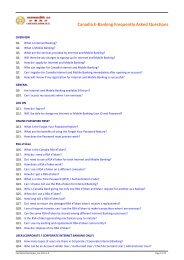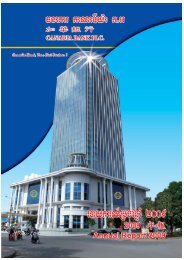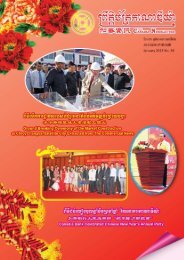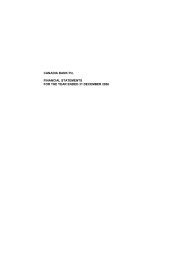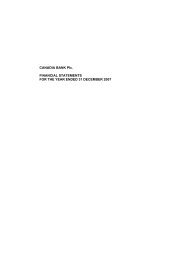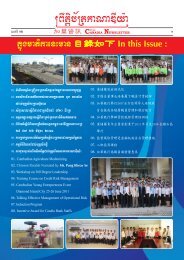Annual report 2008-OK-B-up.qxp - Canadia Bank Plc.
Annual report 2008-OK-B-up.qxp - Canadia Bank Plc.
Annual report 2008-OK-B-up.qxp - Canadia Bank Plc.
Create successful ePaper yourself
Turn your PDF publications into a flip-book with our unique Google optimized e-Paper software.
NOTES TO THE FINANCIAL STATEMENTS<br />
2. SUMMARY OF SIGNIFICANT ACCOUNTING POLICIES (CONTINUED)<br />
2.11 Property and equipment (continued)<br />
Buildings - straight-line 5%<br />
Motor vehicles - declining 25%<br />
Office equipment and furniture - declining 25%<br />
Computers and IT equipment - declining 50%<br />
An asset's carrying amount is written down immediately to its recoverable amount if the asset's carrying<br />
amount is greater than its estimated recoverable amount.<br />
Gains and losses on disposals are determined by comparing the proceeds within the carrying amount and<br />
are recognised in the income statement.<br />
2.12 Computer software<br />
Acquired computer software licences are capitalised on the basis of the cost incurred to acquire the<br />
specific software and bring it to use. These costs are amortised over a two-year period using the declining<br />
balance method.<br />
Costs associated with developing or maintaining computer software programs are recognised as an<br />
expense as incurred.<br />
2.13 Impairment of non-financial assets<br />
Assets that have indefinite useful lives are not subject to amortisation and are tested annually for<br />
impairment. Assets that are subject to amortisation or depreciation are reviewed for impairment<br />
whenever events or changes in circumstances indicate that the carrying amount may not be recoverable.<br />
An impairment loss is recognised for the amount by which the asset's carrying amount exceeds its<br />
recoverable amount. The recoverable amount is the higher of an asset's fair value less costs to sell and<br />
value in use. For the purposes of assessing impairment, assets are gro<strong>up</strong>ed at the lowest levels for which<br />
there are separately identified cash flows (cash-generating units). Non-financial assets other than goodwill<br />
that have suffered impairment are reviewed for possible reversal of the impairment at each <strong>report</strong>ing date.<br />
2.14 Leases<br />
Leases in which a significant portion of the risks and rewards of ownership are retained by the lessor are<br />
classified as operating leases. Payments made under operating leases are charged to the income statement<br />
on a straight-line basis over the period of the lease.<br />
2.15 Provision<br />
Provisions are recognised when: the <strong>Bank</strong> has a present legal or constructive obligation as a result of past<br />
events; it is probable that an outflow of resources will be required to settle the obligation; and the amount<br />
has been reliably estimated.<br />
When there are a number of similar obligations, the likelihood that an outflow will be required in<br />
settlement is determined by considering the class of obligations as a whole. A provision is recognised even<br />
if the likelihood of an outflow with respect to any one item included in the same class of obligations may<br />
be small.<br />
Provisions are measured at the present value of the expenditure expected to be required to settle the<br />
obligation using a pre-tax rate that reflects current market assessments of the time value of money and<br />
the risks specific to the obligation. The increase in the provision due to the passage of time is recognised<br />
as interest expense.<br />
<strong>Annual</strong> Report <strong>2008</strong> 35



